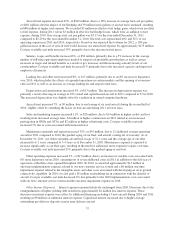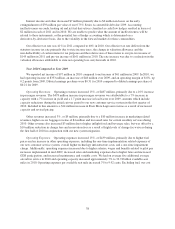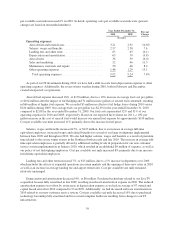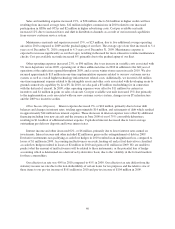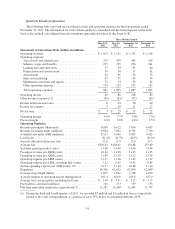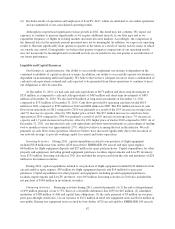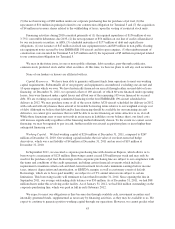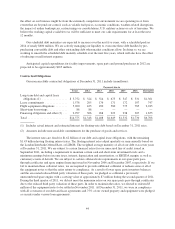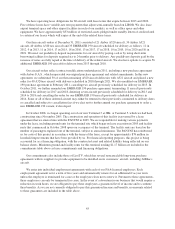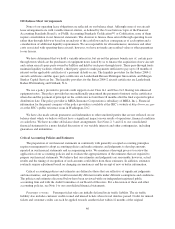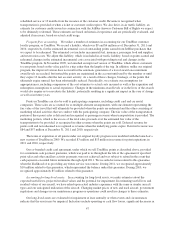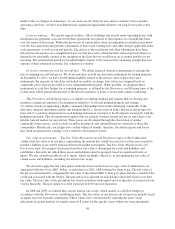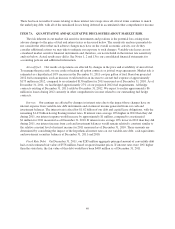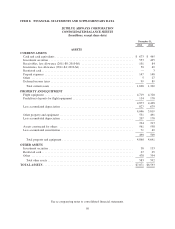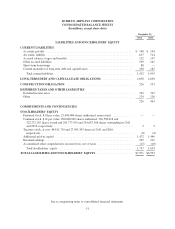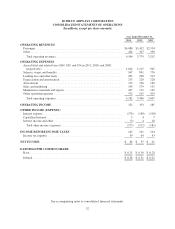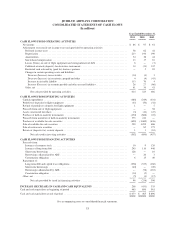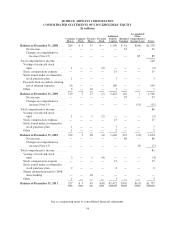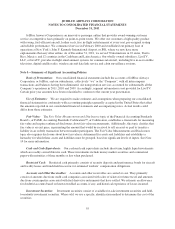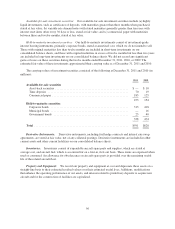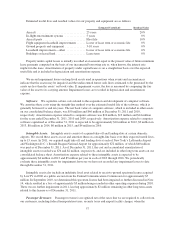JetBlue Airlines 2011 Annual Report Download - page 57
Download and view the complete annual report
Please find page 57 of the 2011 JetBlue Airlines annual report below. You can navigate through the pages in the report by either clicking on the pages listed below, or by using the keyword search tool below to find specific information within the annual report.scheduled service or 12 months from the issuance of the customer credit. Revenue is recognized when
transportation is provided or when a ticket or customer credit expires. We also defer, in air traffic liability, an
estimate for customer credits issued in conjunction with the JetBlue Airways Customer Bill of Rights we expect
to be ultimately redeemed. These estimates are based on historical experience and are periodically evaluated, and
adjusted if necessary, based on actual credit usage.
Frequent flyer accounting. We utilize a number of estimates in accounting for our TrueBlue customer
loyalty program, or TrueBlue. We record a liability, which was $9 and $6 million as of December 31, 2011 and
2010, respectively, for the estimated incremental cost of outstanding points earned from JetBlue purchases that
we expect to be redeemed. The estimated cost includes incremental fuel, insurance, passenger food and supplies,
and reservation costs. We adjust this liability, which is included in air traffic liability, based on points earned and
redeemed, changes in the estimated incremental costs associated with providing travel and changes in the
TrueBlue program. In November 2009, we launched an improved version of TrueBlue, which allows customers
to earn points based on the value paid for a trip rather than the length of the trip. In addition, unlike our original
program, the improved version does not result in the automatic generation of a travel award once minimum
award levels are reached, but instead the points are maintained in the account until used by the member or until
they expire 12 months after the last account activity. As a result of these changes, breakage, or the points that
ultimately expire unused, has been substantially reduced. Periodically, we evaluate our assumptions for
appropriateness, including comparison of the cost estimates to actual costs incurred as well as the expiration and
redemption assumptions to actual experience. Changes in the minimum award levels or in the lives of the awards
would also require us to reevaluate the liability, potentially resulting in a significant impact in the year of change
as well as in future years.
Points in TrueBlue can also be sold to participating companies, including credit card and car rental
companies. These sales are accounted for as multiple-element arrangements, with one element representing the
fair value of the travel that will ultimately be provided when the points are redeemed and the other consisting of
marketing related activities that we conduct with the participating company. The fair value of the transportation
portion of these point sales is deferred and recognized as passenger revenue when transportation is provided. The
marketing portion, which is the excess of the total sales proceeds over the estimated fair value of the
transportation to be provided, is recognized in other revenue when the points are sold. Deferred revenue for
points sold and not redeemed is recognized as revenue when the underlying points expire. Deferred revenue was
$84 and $57 million at December 31, 2011 and 2010, respectively.
The terms of expiration of all points under our original loyalty program were modified with the launch of a
new version of TrueBlue in 2009. We recorded $3 million and $13 million in revenue for point expirations in
2011 and 2010, respectively.
Our co-branded credit card agreement, under which we sell TrueBlue points as described above, provided
for a minimum cash payment guarantee, which was paid to us throughout the life of the agreement if specified
point sales and other ancillary activity payments were not achieved and was subject to refund in the event that
cash payments exceeded future minimums through April 2011. We recorded revenue related to this guarantee
when the likelihood of us providing any future service was remote. During 2011, we recognized approximately
$10 million related to this guarantee, which represented the balance under this guarantee. During 2010, we
recognized approximately $5 million related to this guarantee.
Accounting for long-lived assets. In accounting for long-lived assets, we make estimates about the
expected useful lives, projected residual values and the potential for impairment. In estimating useful lives and
residual values of our aircraft, we have relied upon actual industry experience with the same or similar aircraft
types and our anticipated utilization of the aircraft. Changing market prices of new and used aircraft, government
regulations and changes in our maintenance program or operations could result in changes to these estimates.
Our long-lived assets are evaluated for impairment at least annually or when events and circumstances
indicate that the assets may be impaired. Indicators include operating or cash flow losses, significant decreases in
47


